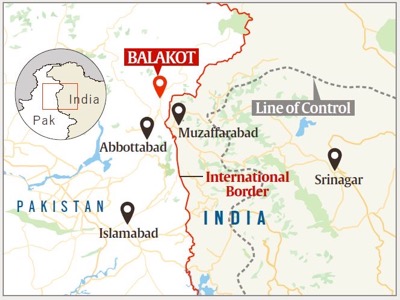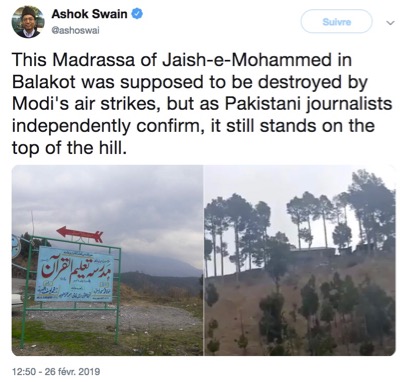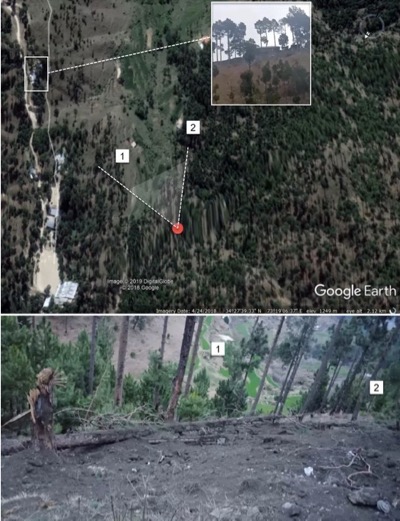On February 14, a terrorist attack killed 40 members of the Indian police force in Pulwama. It was claimed by Jaish-e-Mohammed, the jihadist group that attacked the Indian Parliament in 2001 and tried to assassinate the Pakistani president in 2003. In retaliation, India bombed what it considers to be the seat of the organization in Pakistan. JeM is activated whenever Indo-Pakistan relations improve. For Great game India, the Indian bombardment seems to be a false operation without victims; which seems to confirm the release by Pakistan of an Indian pilot shot.

As a retaliation against Pulwama attack [1], Indian fighter jets carried out strikes against targets inside undisputed Pakistani territory, but open-source evidence suggested that the strike was unsuccessful.
At around 3:30 a.m. local time on February 26, 2019, a flight of 12 Mirage 2000 multi-role fighters reportedly [2] attacked facilities of the terrorist group Jaish-e-Mohammad (JEM) near Balakot town in Mansehra District, Pakistan. Using open-source evidence, we were able to geolocate the site of the attack and provide a preliminary damage assessment.
While most sources [3] at the time identified the strike as taking place in the Pakistani town of Balakot, others [4] located the strike at “Jaba Top,” a likely reference to a mountain top near the village of Jaba, about 10 kilometers south of Balakot.
Identification
On the morning of the February 26, after daybreak, a spokesperson for the Pakistan Armed Forces, Major General Asif Ghafoor, tweeted images from what he alleged to be the impact area of the Indian bombs.

Ghafoor claimed that the payload was dropped in a hurry and impacted in an open area. The immediate imagery seemed to corroborate the statement, as the photographs were taken in a wooded area and did not show any damaged structures.
Two photos included fragments from the ordinance supposedly dropped by the Indian fighter jets. One image contained what looked like a set of tail fins and another what appeared to be a component for the targeting system.
The most identifiable photo was of the fins, which closely resembled those on the Israeli-produced SPICE-2000 precision-guided munitions (PGM). SPICE uses INS/GPS coordinates for autonomous navigation and electro-optical seekers for target identification and terminal navigation. According to Rafael, the manufacturer of the SPICE series of PGMs, the electro-optical sensor matches the scene with pre-loaded imagery for accurate target acquisition and homing.

Initial reports stated that Mirage 2000s dropped 1,000-kilogram (approximately 2,000 pound) bombs on their targets, which is the same size of the SPICE-2000. This was corroborated by later reports [5], which stipulated [6] that the SPICE-2000 was used in the strike. These munitions are compatible with the fighter jets, lending credibility to this assessment.
Location of the Strike
India claimed [7] administered Kashmir and near the town of Jaba, was largely destroyed, resulting in the death of hundreds of militants.
Satellite imagery, acquired by Planet Labs Inc. on the morning of 27 February, calls this claim into question. No evidence of damage to the facility or nearby areas is visible on the images. Local media have visited the site and published photographs [8] of multiple small craters in the vicinity, but they haven’t been granted access to the facility that was reportedly targeted. Satellite imagery, presented and analysed below, provides no apparent evidence of more extensive damage and on the face of it does not validate Indian claims regarding the effect of the strikes.

By analysing areas of healthy vegetation from the imagery, I’ve been able to identify three clear impact areas between 150 and 200 metres from the edge of the facility. These correspond to photos shared by local journalists and confirm the location of strikes.

In addition to the imagery posted by the Pakistan Armed Forces spokesperson, video footage emerged of the area near the strike, showing a second point of impact. The video showed locals talking about the strike and claimed that only one man received injuries as a result of being startled by the bomb blasts.

The video posted on social media showed a valley similar to the one appearing in the video shared by the Pakistan Armed Forces spokesperson. A single cluster of buildings was visible on top of the mountain ridge. Imagery posted by Uppsala University Professor and UNESCO chair Ashok Swain on Twitter showed a closeup of this building, allowing for a clearer view of the area.

Using this more detailed imagery, we were able to confirm conclusively that this strike did in fact take place near Jaba Top. A comparison between tree clusters and the buildings visible in the imagery provided a positive match.

Using this information, we were also able to verify the initial imagery from the Pakistan Armed Forces spokesperson as being from the same location. In the graphic below, the video footage would have been taken from structure number two as marked in the satellite imagery and ground-level imagery.

Retired Indian Colonel Vinayak Bhat seemed to agree with this assessment in an article written in the immediate aftermath of the attack, showing satellite imagery [9] of the same location.
Additional footage of the targeted facility was released on Twitter. In one tweet, Asian News International (ANI) posted an image of what appeared to be a gate and guard post to the entrance of the facility. As Bhat also pointed out, this structure bore a high resemblance to a point along the road leading to the facility on satellite imagery.

The blue roof combined with the half roof covering the road and the sideroad on the right all contributed to a high-confidence conclusion that these structures were the same.
Damage Assessment
Another video from the main point of impact allowed US to better survey the extent of the damage. The video showed a large patch of wooded area affected by the bombing, but no sign of damaged structures or personal injury.

Viewing satellite imagery from Planet, a small change in the affected area was visible, indicating the point of impact. Imagery from February 26 was not available, but a comparison from February 25 to 27 was possible, allowing for a reliable before and after comparison of the target location.

The change visible in the imagery indicated only impacts in the wooded area, with no damage being visible to the surrounding structures.
Conclusion
Using open-source evidence and satellite imagery, we were able to confirm the location of the Indian airstrike to be near Balakot, rather than inside it, and firmly within Pakistani territory. The target was supposedly a JEM-led madrassa, but we were unable to confirm that any bombs reached buildings associated with it.
The recent tension between India and Pakistan has been marked by disinformation from both sides. Local media’s reporting of unsubstantiated facts and rumours, together with online trolls, have made it difficult to discern the reality of the situation. The satellite imagery suggests that the claims made by India’s Ministry of External Affairs of ‘a very large number’ of militants being killed in the strike are likely false.
The SPICE-2000 is a precision-guided bomb that should not miss its target by the approximately 100 meters that the impact craters were from the nearest structures. The autonomous nature of the SPICE-2000 adds mystery to why the bombs seemed to miss. Satellite imagery did not suggest that any damage was inflicted to nearby buildings. Vegetation and low imagery resolution could hypothetically obscure structural damage, but this remains highly improbably. Something appears to have gone wrong in the targeting process — exactly what, however, remains unclear in the open-source evidence.
[1] Refer to Great Game India wiki on Pulwama Attack.
[3] “Balakot: Indian air strikes target militants in Pakistan”, BBC, February 26, 2019.
[4] “Surgical strike on Pakistan: Exact target of IAF operation identified as Jaba Top; air force carried out several hits around site”, First Post, February 26, 2019.
[5] “India used Israeli arms for strike inside Pakistan — report”, Judah Ari Gross, Times of Israel, February 26, 2019.
[6] “All about IAF’s SPICE-2000 bomb used in Balakot attack”, Shaurya Karanbir Gurung, Economic Times, February 27, 2019.
[7] “Indian Statement on the Strike on JeM training camp at Balakot”, by Sushma Swaraj, Voltaire Network, 26 February 2019.
[8] “At raid site, no casualties and a mysterious school”, Asad Hashim, Al-Jazeera, February 28, 2019.
[9] “This hill-top near Balakot is the possible location of the IAF’s strike on Jaish camp”, Colonel Vinayak Bhat, The Print, February 27, 2019.
 Articles by this author
Articles by this author






















Stay In Touch
Follow us on social networks
Subscribe to weekly newsletter